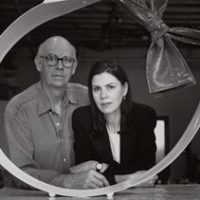

Claes Oldenburg was born in Stockholm, Sweden, in 1929. After living in New York City, Rye, New York, and Oslo, Norway, he moved to Chicago in 1936. Oldenburg attended Yale University from 1946 to 1950 and became an American citizen in 1953. Following work as an apprentice reporter at the Chicago City News Bureau and studies at The Art Institute of Chicago, he settled permanently in New York City in September 1956.
Using as his subject matter the common and commercial objects in his urban surroundings, especially the city’s Lower East Side, Oldenburg established himself at the beginning of the 1960s with a series of installations and performances, among them The Street (1960), The Store (1961), and Ray Gun Theater (1962), which contributed significantly to the emergence of American Pop art. During a stay in Los Angeles in 1963, he focused on subjects inspired by what he called The Home, including the installation Bedroom Ensemble (1963). He went on to create performances in Los Angeles (Autobodys, 1963), Chicago (Gayety, 1963), Washington, D.C. (Stars, 1963), New York (Washes and Moveyhouse, 1965), and Stockholm (Massage, 1966). In 1964, after showing sculptures based on European edibles in Paris, he returned to New York and, continuing to use ordinary, everyday objects as his means of expression, developed “soft” sculptures and fantastic proposals for buildings and civic monuments.
At the end of the decade, Oldenburg took up fabrication on a large scale with Lipstick (Ascending) on Caterpillar Tracks (1969), which became a controversial focus for student protest when it was installed on the campus of Yale University, followed by other works such as Geometric Mouse (1969), Giant Ice Bag (1970), Giant Three-Way Plug (1970), Standing Mitt with Ball (1973), and Alphabet/Good Humor (1975). His first sculpture to be realized in urban scale, the 45-foot-high Clothespin, was installed in downtown Philadelphia in 1976. Soon thereafter, he began working with Coosje van Bruggen; they were married in 1977.
Coosje van Bruggen was born in Groningen, the Netherlands, in 1942. After receiving a master’s degree in art history from the Rijksuniversiteit in Groningen, she served as a member of the curatorial staff of the Stedelijk Museum in Amsterdam from 1967 to 1971, a breakthrough period for Conceptual and Earth Art and Arte Povera. She was co-editor of the catalogue for Sonsbeek 71, an exhibition of contemporary sculpture held in Park Sonsbeek, Arnhem, and at other sites throughout the Netherlands. From 1971 to 1976 she taught fine arts and art history at the Academy of Fine Arts in Enschede, the Netherlands.
Van Bruggen worked in partnership with Claes Oldenburg since 1976, when they rebuilt and relocated Trowel I, originally shown at Sonsbeek 71, to the sculpture garden of the Kröller-Müller Museum in Otterlo, the Netherlands. In 1978 van Bruggen moved to New York (becoming an American citizen in 1993) where she continued to work with Oldenburg to establish direct contact with a wider audience by creating site-specific large-scale urban works. Their collaboration eventually extended to smaller-scale park and garden sculptures as well as to indoor installations.
Over the next ten years, Coosje van Bruggen also served as an international independent curator and critic and lectured widely: she was a member of the selection committee for Documenta 7 in Kassel, Germany (1982); a contributor to Artforum (1983-1988); and Senior Critic in the Department of Sculpture at Yale University School of Art in New Haven (1996-1997). In addition to her extensive writings on Oldenburg’s early work and on the collaborative projects, she created the characters for the performance Il Corso del Coltello (Venice, 1985). Van Bruggen is the author of essays on Richard Artschwager and Gerhard Richter and books on John Baldessari, Hanne Darboven, Bruce Nauman and Frank O. Gehry’s Guggenheim Museum Bilbao.
Ms. van Bruggen passed away in Los Angeles, CA in January 2009.


